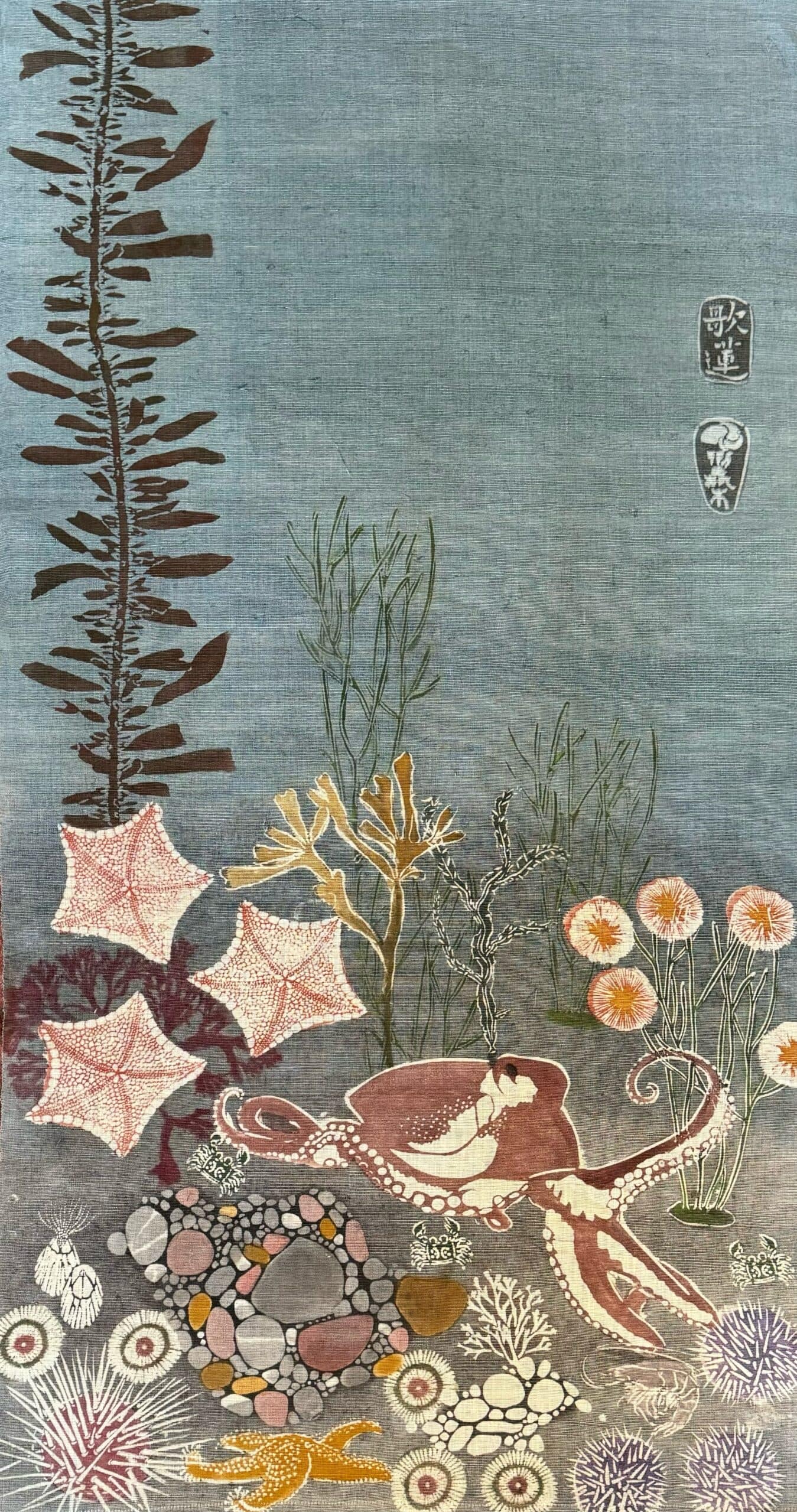Portland Japanese Garden is a natural vehicle through which to explore Japanese art and design. Art exhibitions explore ideas and aesthetics integral to the fabric of life in Japan. Introducing a wide array of artists and art forms, these exhibitions reflect on ways we experience peace through connections to art, nature, and one another.
Art exhibitions at Portland Japanese Garden began with Diane Durston, Curator Emerita (former Arlene Schnitzer Curator of Culture, Art and Education from 2007-2018). It launched with a series of four special exhibitions a year— one for each of the four seasons—that would reflect the intersection of art and nature and introduce the importance of seasonality in Japanese art and gardens. The exhibitions would celebrate work influenced by the aesthetics of Japan or created in response to the Garden itself.
Aki Nakanishi, Portland Japanese Garden’s current Arlene Schnitzer Curator of Culture, Art, and Education explains, “Traditionally, the role of Japanese gardens is to offer a place of quiet contemplation detached from the noise of modern society. But at the same time, Japanese gardens have always embraced, if not strived for a sense of symbiosis created at the intersection of architecture, art, and nature, which demonstrates the balance that can be achieved when nature and human ingenuity converge.”
Now more than a decade later, Portland Japanese Garden has successfully introduced the work of more than 75 artists representing Japan and its unique artistic traditions. The works come from internationally known artists—some of whom have been recognized as Living National Treasures in Japan, as well as rising young artists and artisans from all parts of the country.
Natural Patterns: Katazome Stencil Dyeing
March 29th, 2025 – September 15th, 2025


Experience a range of nature-inspired artwork as diverse as the ecology of the Pacific Northwest itself!
Primarily used for elaborate patterns on kimono and yukata, katazome is a method of using exquisitely cut paper stencils and resist paste to dye fabrics. Today, katazome-created designs can be stand-alone art pieces, or are often found on noren curtains, futon covers, and furoshiki gift wraps.
Related: Learn more about the exhibiting artist, Karen Illman Miller
Local Oregon artist, Karen Illman Miller, has practiced katazome for the past 30 years, infusing her designs with inspiration from the natural world and drawing from her background as a marine biologist. The Calvin and Mayho Tanabe Gallery will host Miller’s extraordinary art, which fuses traditional Japanese dyeing with our local landscape. The hallway located just outside of the Yanai Family Classroom will feature a selection of antique katazome stencils collected by Miller throughout her artistic career.
Related: Discover the process that goes into making this stunning artwork
From March 29th through June 5th, the Tanabe Gallery will feature katazome artwork featuring flora and fauna of the Oregon landscape, including many plants found within Portland Japanese Garden itself. Starting June 7th, the second half of the exhibition will explore the rich tapestry of ocean life.
Read Karen Illman Miller’s artist bio and artist statement on the Artist Talk Event Page.
Explore Previous Art Exhibitions
2022 Art Exhibitions
- Garden of Resonance: The Art of Jun Kaneko (10/1/2022 – 2/20/2023)
- Intimate Landscapes: Masterpieces from the Anderson Collection (7/15/22 – 9/12/22)
- Gifts from Japan: A Horticultural Tale Told Through Botanical Art (5/14/2022 – 7/4/2022)
- Fashion and Fantasy: The Art of Netsuke Carvings (2/12/22 – 4/17/22)
- Art of Vitality: Peter Shinbach Bamboo Art Collection (1/1/22 – 4/25/22)
- Ukiyo-e to Shin Hanga: Changing Tastes in Japanese Woodblock Prints (11/20/21 – 1/30/22)
2021 Art Exhibitions
- Ukiyo-e to Shin Hanga: Changing Tastes in Japanese Woodblock Prints (11/20/21 – 1/30/22)
- Painting Paradise: Art of Daisuke Nakano (6/12/21 – 7/18/21)
- FISH-MAN: Tatsuki Masaru (4/24/21 – 7/18/21)
- The Gates of Hope: Connecting Cultures (4/24/21 – 5/31/21)
- Ishimoto Yasuhiro: Architecture + Nature + Culture (2/18/21 – 4/11/21)
- Healing Nature: Gardens and Art of Manzanar with photographs by Ansel Adams, Dorothea Lange, and Toyo Miyatake (12/4/20 – 1/21/21)
2020 Art Exhibitions
- 究 (kyu) – The Pinnacles of Japanese Ceramic Art from the Anderson Collection (9/26/20 – 10/25/20)
- Tatsuzo Shimaoka | The Language of Texture (9/1/20 – 10/31/20)
- Japanese Ceramics Exhibition | “連” (ren) Forging a Sense of Solidarity (6/19/20 – 7/19/20)
- Spirits Rising: ひろしま / hiroshima by Ishiuchi Miyako (1/18/20 – 3/15/20)
- Virtual Exhibition: The Brush of Shoko Kanazawa
2018 Art Exhibitions
- Manga Hokusai Manga (12/1/18 – 1/14/19)
- Gion Matsuri: The World’s Oldest Urban Festival (9/15/18 – 11/4/18)
- Shokunin: Five Kyoto Artisans Look to the Future (5/12/18 – 7/8/18)
- Hanakago: The Art of Bamboo and Flowers (2/3/18 – 4/1/18)